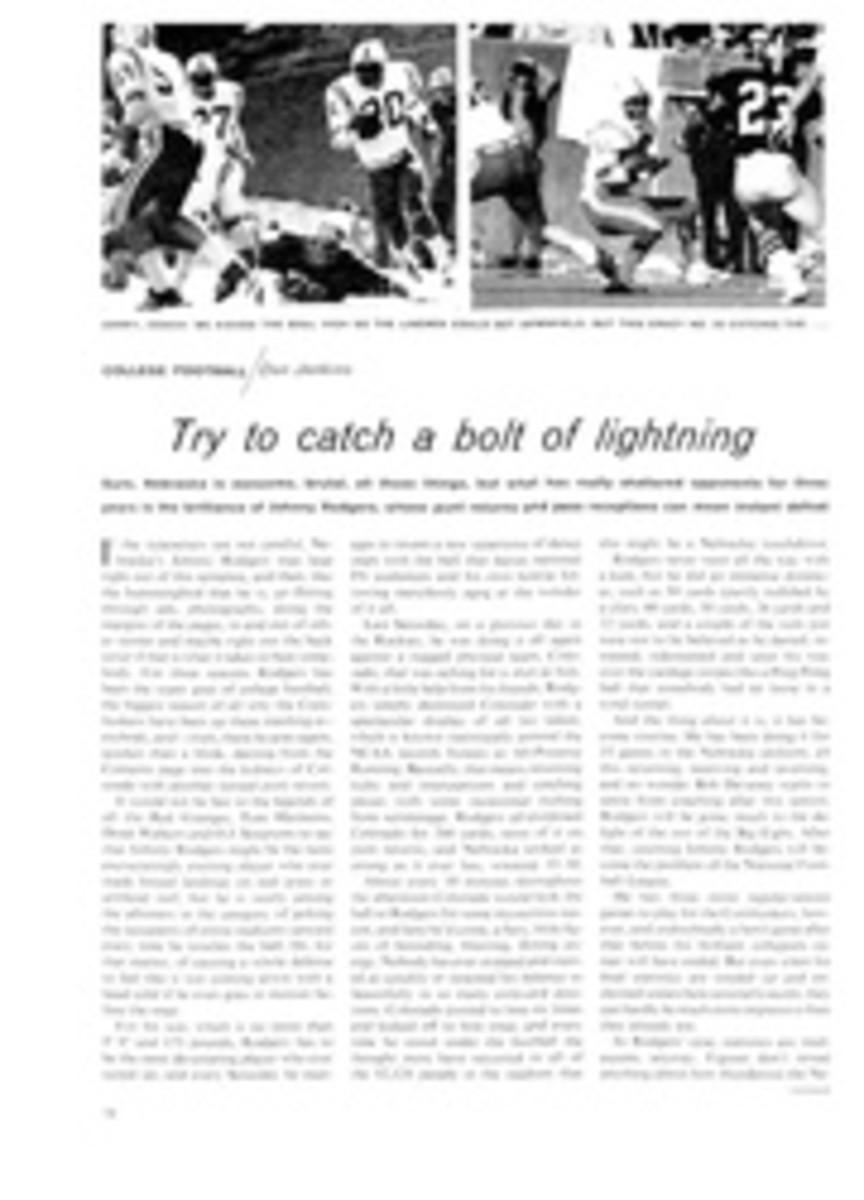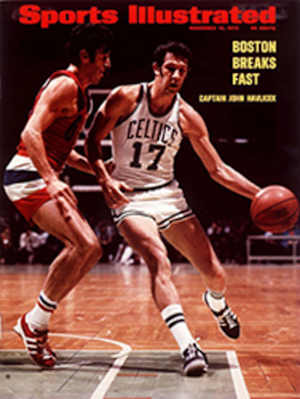
SWARM TO DAYLIGHT
Every year, when the professional football wars are over, Fuzzy Thurston, the old Green Bay left guard, gives a dinner for all the NFL backs who have gained 1,000 yards or more in a season. In the past, it has been a quiet affair, since there are usually about as many running backs who gain 1,000 yards as there are 25-game winners in baseball. But after this season Fuzzy may have to enlarge his restaurant.
It is appropriate that Thurston should give the dinner; he was one of the blockers who cleared the way for Jim Taylor and Paul Hornung in the days when the Packers were synonymous with the power sweep. Today, quite a few teams have a pair of runners on a par with Taylor and Hornung. The running game, long used primarily to give the receivers and isolated cameras a rest, is back.
A number of factors are involved in the dramatic reemphasis of the run, but two are most dominant. Bringing each of the hash marks 3 7/12 yards closer to the center of the field has made more difficult the defenders' job both on the pass and the run, and the almost universal use of pass-conscious zone defenses has opened the way for the exceptional runners who populate backfields today.
One of the best is Floyd Little, the bandy-legged, short-coupled water bug who is the key to the Denver Bronco offense. Though only 5'10" and 196 pounds, Little led the NFL in rushing in 1971 with 1,133 yards. This year, playing on a last-place team, he already has 573 yards on 123 carries.
Little is an intense, thoughtful man, and he has carefully considered the techniques and the problems of the running back. "Sure, moving the hash marks has made a difference," he said the other day in Denver, perched on a rubbing table in the locker room. "Used to be, when you had the ball on the hash mark, they would overload to the wide side, because they could use the sideline to contain you the other way. Now, they can't overload, so you can sweep either way."
He stretched his legs out and contemplated an arc that left a four-inch gap between his knees—even though his ankles were together. Little's physical eccentricity hardly impairs his efficiency, and, of course, there have always been many outstanding bowlegged or pigeon-toed athletes: Honus Wagner, Babe Ruth, Jimmie Foxx, Mickey Walker, Jackie Robinson, Johnny Unitas, Bob Hayes, Bobby Orr. "I think if my legs were straight, I'd be 6'2", not 5'10"," Little joked.
"You see," he went on, "with the new hash marks, the linebacker can't cheat over and the tackles have to spread a little wider. You can see it on a sweep. You get the extra step on the linebacker. Then the quick traps up the middle work better. Another thing, the sweeps make those big defensive linemen run a lot more than they had to and they tire out toward the end of the game."
Not everyone in the rushing profession agrees entirely with Little. Frenchy Fuqua, the black running back for the Pittsburgh Steelers who maintains that he was born a French count and spent so much time sunning himself on the Riviera that it changed his complexion for good, says, "I don't think the hash marks—just an extra three yards—make that much difference."
Frenchy, who outgains most backs in the league and outdresses them all, explains: "Your big backs, like Larry Csonka, are not heading for the sidelines. The sidelines might be a help to the quick backs like O. J. Simpson, Carl Garrett—the real quick backs—Mercury Morris. But to the average back, the hash marks don't make a difference."
Of course, it seems that there are no merely average backs left. Twenty-seven different backs on 20 different teams have rushed for 100 yards or more in at least one game this year. In just eight weeks of play there have been 43 100-yard performances as opposed to 48 all last season (14 weeks). About a dozen runners are setting a pace that would bring them in over 1,000 yards (and only once have as many as half a dozen hit 1,000. As recently as 1969 there was only one—Gale Sayers).
As the chart (below) shows, team rushing yardage is increasing precipitously. This year only three teams, all of them weak ones (New Orleans, New England and Denver), have tried more passes than runs. By contrast eight of the 26 NFL teams have gained more yards running than passing, and of those, five either lead their division or are tied for the top.
O.J. Simpson of Buffalo, who is surpassed only by Washington's Larry Brown in total rushing yardage—despite playing for such a poor team—says, perhaps somewhat enviously: "The winning teams are running teams, and the other teams are trying to emulate them. The Cowboys and the Dolphins—the two Super Bowl teams last year—were running teams. When the Jets won the Super Bowl, they had Joe Namath and the pass, and a lot of clubs tried to develop the same thing. This led to defenses setting to stop the pass by using zones. So clubs began to run to beat the zone. Now all NFL teams have good runners."
Says Steve Owens of Detroit, who made the 1,000 club last year: "One back used to carry the brunt of the running. Now everybody has two, and the defense can't key on one runner. If they stop me, they can't stop Altie Taylor. It doesn't matter who carries, we're going to gain yards running."
So many colleges have turned to the Wishbone attack, which places a premium on running, that more of the best young athletes are being trained as runners. Now the quarterbacks coming out of college tend to be a new stampede breed. Chicago's Bobby Douglass, Pittsburgh's Terry Bradshaw, New England's Jim Plunkett and Dallas' Roger Staubach are all useful runners.
The threat of the deep pass has also helped to make the run a bigger factor. Walt Garrison of Dallas says, "The linebackers have zone responsibility on the pass and they have to drop deep. This leaves it up to the front four to stop the run. The linebackers can't get up quick enough to help out."
Calvin Hill, the other Cowboy running back, sees it somewhat differently: "It's harder to make a long run against the zone. Once you clear the line of scrimmage, the wide receiver often can't find his guy to block downfield."
Hill, like many running backs in the league, considers Washington's Larry Brown the best in the business. "Brown is unbelievable," he says. "And that's coming from a fellow who looks at him with a certain amount of jealousy."
Brown runs behind a sophisticated offensive line. George Allen, the coach of the Redskins, has taken a page from the Lombardi book—the book called Run to Daylight! Pittsburgh's Fuqua explains what this can mean: "I wouldn't want to be a defensive lineman, even if I was big enough to play there. Offenses today are running so many variations that look like the same thing that a defensive lineman has to be confused. If he reads his key and is sure it's a solid key read, it still may not be what he thinks it is."
Four Steeler backs—Fuqua, Bradshaw, Steve Davis and Franco Harris, the NFL's leading rookie rusher—have averaged more than five yards a carry so far this season. That means, at least theoretically, that if Bradshaw stuck exclusively with a running game the Steelers would make a first down every second play.
The rushing renaissance has been so sweeping that it has embraced all types. Everybody is running: quarterbacks and setbacks, old backs and young backs, all-star backs and mystery backs—such little-known names as Bob Thomas, Jim Harrison, Josh Ashton and Doug Dressier have all carried for 100 yards at least once this year—big backs and little backs. Bruisers like the Cowboys' Hill, the Lions' Owens, Csonka of Miami, John Riggins of the Jets, John Brockington of Green Bay and Marv Hubbard of Oakland all go well over 200 pounds, but at the other end of the scale there are a number of good, relatively small men: Fuqua, Essex Johnson of Cincinnati, Mike Garrett of San Diego, and the indomitable Little.
Running backs, by the very nature of their job, have a short life expectancy in pro football. They are hit on almost every play—often by a man who outweighs them by some 20%. When they carry, they are gang-tackled; when they do not, they block either for the passer or for the other ballcarrier in the backfield, and they are always overmatched.
"You have to realize how short your life as a pro football player can be," says Little. "I know I don't have long to go in this business. So every time I run the ball, I run it like it is going to be the last time. You give it everything you've got and accept the possibility you're going to get hurt. I've been hurt a lot of times, but, you know, the way my legs are structured, I can take a blow from the side and not be hurt. See how bowed they are? When I get hit at knee level from the side, it just straightens my leg in to where it should have been to begin with. So I haven't had any really serious knee injuries."
Still, he has had to play with rib, back and shoulder injuries. "Floyd will play hurt," says Lou Saban of Buffalo, Little's former coach in Denver. "It is important for him to play no matter what his condition because he feels a responsibility to the team. Floyd has a driving force that no one I know can equal. He is a man. That's about as much as you can say about anybody."
Two weeks ago the grateful fans of Denver celebrated Floyd Little Day, honoring him for his many contributions to team and city. It was an impressive tribute. But—on the subject of recognition—if the runners all over the league keep up their present pace, Fuzzy Thurston is going to have to build a grandstand to hold the new members in his 1,000-yard dinner crowd.
[originallink:10567381:43127]
TWO PHOTOS
Following Frenchy Fuqua (33), leading rookie Franco Harris carries Pittsburgh into first place past Cincinnati, while (right) O. J. Simpson tries to blast Buffalo out of the blues.
PHOTO
Dave Hampton may be first 1,000-yard Falcon.
PHOTO
CHART
PHOTO
Floyd Little, last year's league rushing champion, is a bowlegged, bantam, brave Bronco.
PHOTO
Packer Brockington made 133 yards Sunday.

